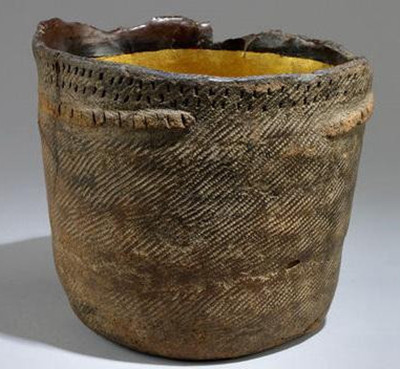Thousands of years ago, one of our ancestors must accidentally have made their first pot. We can imagine that a lump of wet clay somehow ended up in the fire, dried out, hardened and formed a hollow shape; a shape that could hold things, in a tough material.
數千年前,我們某一祖先在偶然間創造出了首件陶器。我們可以想象一塊濕泥巴最后在火上燒制,烘干,變硬,形成一件形狀中空的器皿,材料簡陋,不過可以盛放東西。
Until now, for the Ice Age cook, leaves were soggy, baskets and skins leaked and burned, and meat charred. Suddenly, when that wet clay hardened, a whole world of culinary possibilities and ceramic design opened up.
從冰河時代的廚師們,到此之前,人類學會了浸漬樹葉,編制籃子,革制獸皮,烘烤獸肉。然而當人類掌握了用火烤硬濕粘土的技術,忽然之間,開辟了一個新興烹飪技術與陶瓷設計的嶄新世界。
The miraculous accident that produced pottery coincided with some great developments in human history. In the previous four programmes, I've been looking at the way humans began to rear animals and to cultivate plants. As a consequence, they started to cook differently, to eat new things and therefore to live differently-they settled down. Today, we're in Japan, about seven thousand years ago, with an ancient pot made in a tradition that goes back almost ten thousand years before that.
這化腐朽為神奇、偶然間的陶器制作,正好與人類歷史上其他偉大的發展相呼應。之前的四集節目里,我一直在介紹人類是如何馴化牲畜、培育作物。因此,他們開始采用不同的方式來烹制食物,吃的方式也改變了;然后過上了一種全新的定居生活。今天,我們來到了大約七千前年的日本,來尋找一件無意間創造出來的陶器。然而制作似類陶器的歷史,卻可以追溯到萬年之前。
The earliest dates we've got for pottery are around about 16,500 years ago, and that in itself has caused quite a fuss because this is still what most people recognise as the Old Stone Age - with people hunting big game animals. We don't really expect to find pottery quite as early as that.
“迄今為止我們發現的最早陶器大約16500年的歷史。這發現本身真是一石激起千層浪呵,因為那是大家公認的舊石器時代,當時原始人類還在依靠狩獵大型野生動物謀生。我們根本沒料到居然會出現那么早期的陶器。”西蒙·康爾說道。
It was in Japan that the world's first pottery was born-and with it, possibly the world's first stew.
世界上第一件陶器是在日本誕生的,也很可能相應地促成了世界第一缽燉湯的出現。
A history of the world.
世界歷史,
In a hundred objects.
百件藏品,
Jomon pot, a clay pot from Japan,approximately 5,000 BC
距今約一千三百年前出土于洪都拉斯的瑪雅玉米神靈石像。
You'll find pots in museums all around the world and here in the Enlightenment Gallery of the British Museum, we have pots from all over the world; Greek vases with heroes fighting on them, Ming bowls from China, pot-bellied African jars and beautiful Wedgwood tureens.
你會在世界各地的博物館以及大英博物館的啟蒙展館找到各種各樣的盆缽鍋罐;我們收藏有來自世界各地的展品,來自希臘的陶罐,上邊描繪了戰斗中的英雄,來自中國的明代古碗,來自非洲的大腹罐,還有美麗的韋奇伍德砂鍋。
The world's pots are so ubiquitous that we take all of them for granted, but human history is told and written in pots perhaps more than in anything else; as Robert Browning put it: Time's wheel runs back or stops; potter and clay endure.
這世界上的鍋碗瓢盆、罐頭缽頭隨處可見,我們都已經習已為常了;然而這些盆盆罐罐可以講述或記錄的人類歷史,卻可能比其他任何物品都要多。下如羅伯特·布朗寧說的:“不管滄海桑田、時光流逝,陶器與粘土生命永恒。”












